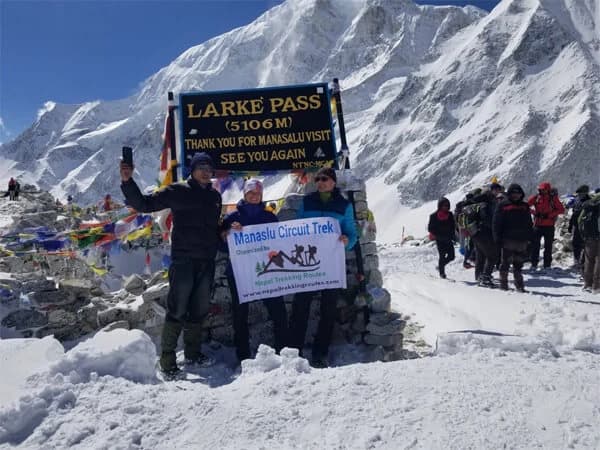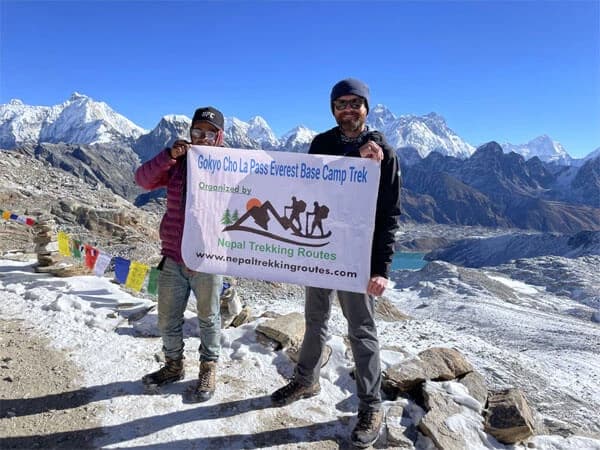Manaslu Round Trek 14 Days Overview
Manaslu Round Trekking is an extraordinary adventure. It is one of Nepal’s most captivating and lesser-known regions. Managed by Nepal Trekking Routes Pvt. Ltd., this trek circles the majestic Mount Manaslu, the world’s eighth-highest peak, providing trekkers with an unparalleled experience of high-altitude trekking and profound cultural immersion. This trek is perfect for those seeking to explore diverse terrains, from verdant forests and serene villages to dramatic mountain passes, all set against the stunning backdrop of the Himalayas.
Located approximately 50 miles from Kathmandu in the Gorkha district, the Manaslu Round Trek takes you through the remote and beautiful Manaslu region. This off-the-beaten-path journey passes through traditional settlements of the Gurung community and other ethnic groups like the Bhutias and Sherpas, offering a unique glimpse into their way of life. The area is rich in Buddhist heritage, with numerous monasteries, mani walls, chortens, and other landmarks adorning the trails. The trek's highlight, the challenging Larke Pass, provides awe-inspiring views of rivers, waterfalls, and towering mountain vistas, ensuring a truly enriching and eco-friendly trekking experience within the Manaslu Conservation Area. With a well-balanced itinerary that includes ample acclimatization, Nepal Trekking Routes ensures that trekkers can fully appreciate the natural beauty and cultural richness of this remarkable Himalayan region.
Major Highlights of the Manaslu Round Trek
- Spectacular vistas of Manaslu, Ganesh Himal, and Larke Peak from Larke La Pass.
- Immersive cultural encounters with the Gurung, Bhutia, and Sherpa communities.
- Diverse landscapes featuring lush forests, tranquil rivers, and rugged mountains.
- Views of prominent peaks including Himlung Himal, Annapurna, Kang Guru, and Cheo Himal.
- Challenging and rewarding crossing of the high-altitude Larke La Pass.
- Exploration of dense forests home to rare wildlife such as Himalayan Tahr and Snow Leopard.
- Warm and welcoming hospitality from local Himalayan communities.
- Visits to ancient Buddhist monasteries, mani walls, and chortens along the trail.
- Unique insights into traditional Himalayan lifestyles and practices.
- Eco-friendly trekking practices promoted throughout the Manaslu Conservation Area.
Why Choose the Manaslu Round Trek?
Choosing the Manaslu Round Trek offers a unique blend of stunning natural beauty and deep cultural immersion. This trek is perfect for adventurers looking to explore the serene and less-crowded trails of the Manaslu region, providing a tranquil and authentic trekking experience. Managed by Nepal Trekking Routes the journey takes you through diverse landscapes, from lush forests and alpine meadows to the challenging high-altitude Larke Pass, offering breathtaking panoramic views of towering peaks. Along the way, you'll encounter traditional villages, engage with the local Gurung, Bhutia, and Sherpa communities, and witness their ancient Buddhist practices and warm hospitality. Emphasizing eco-friendly practices, this trek ensures a sustainable adventure that respects and preserves the natural environment.
Key Points:
- Stunning views of Mount Manaslu and surrounding peaks.
- Less-crowded and serene trekking paths.
- Diverse landscapes including forests, meadows, and high-altitude passes.
- Cultural immersion with Gurung, Bhutia, and Sherpa communities.
- High-altitude challenge of crossing the Larke Pass.
- Warm hospitality and ancient Buddhist traditions.
- Eco-friendly trekking practices for sustainable travel.
Mountain View during the Manaslu Round Trek
During the Manaslu Round Trek, trekkers are treated to some of the most breathtaking mountain views in the Himalayas. Here are the highlights:
- Mount Manaslu (8,163m): The centerpiece of the trek, offering stunning views from various points along the trail.
- Ganesh Himal: Visible in the early stages of the trek, adding to the picturesque landscape.
- Himalchuli and Ngadi Chuli: These peaks provide a dramatic backdrop as you ascend higher into the Manaslu region.
- Himlung Himal (7,126m): A striking peak visible from the higher altitudes, especially near the Larke Pass.
- Annapurna Range: Distant views of Annapurna II and IV can be seen, adding to the trek’s visual splendor.
- Cheo Himal and Kang Guru: Visible from the Larke Pass, offering panoramic views that are truly mesmerizing.
- Larke Peak (6,249m): Close views from the pass, enhancing the sense of achievement upon crossing it.
These mountain views, combined with the trek’s diverse landscapes, make the Manaslu Round Trek an unforgettable journey through some of the most spectacular scenery in the Himalayas.
Larke La Pass
The Larke La Pass is one of the most significant highlights of the Manaslu Round Trek, standing at an impressive 5,160 meters (16,929 feet). This high-altitude pass presents a challenging yet rewarding experience for trekkers. As you approach the pass, the landscape transforms into a rugged, high-altitude environment with breathtaking panoramic views of the surrounding peaks, including Himlung Himal, Cheo Himal, Kang Guru, and the Annapurna range. The ascent to Larke Pass involves navigating through rocky terrain and possibly snow, depending on the season, adding to the sense of adventure. Reaching the top of the pass offers a sense of accomplishment and is often considered the pinnacle of the trek, with the stunning vistas making every effort worthwhile. The descent from Larke Pass leads to the beautiful valley of Bimtang, where trekkers can rest and reflect on their incredible journey through one of Nepal's most scenic and remote regions.
Best Time to Do the Manaslu Round Trek
Spring (March to May)
Spring is one of the best times to undertake the Manaslu Round Trek. During these months, the weather is generally stable, with mild temperatures and clear skies providing excellent visibility of the surrounding peaks, including Mount Manaslu. The trail is adorned with blooming rhododendrons and other wildflowers, adding vibrant colors to the landscape. This season also offers a great opportunity to observe the local wildlife in the Manaslu Conservation Area as they become more active after the winter months. The pleasant weather conditions make the challenging sections of the trek, such as the crossing of Larke Pass, more manageable and enjoyable.
Autumn (September to November)
Autumn is another ideal season for the Manaslu Round Trek, characterized by stable weather and clear skies after the monsoon rains have cleared. This period offers some of the best mountain views, with the air being crisp and the skies largely cloud-free. The temperatures are comfortable during the day, although it can get chilly at higher altitudes and during the nights. The autumn months also coincide with the harvest season, providing trekkers with a unique cultural experience as they witness local festivals and traditional agricultural practices. The trails are in excellent condition, and the natural beauty of the region is at its peak, making autumn a highly popular time for trekking in the Himalayas.
Winter (December to February)
While winter trekking on the Manaslu Round Trek is possible, it is generally more challenging due to colder temperatures and the likelihood of snow, especially at higher altitudes like Larke Pass. The trails are much quieter during this season, offering a more solitary and peaceful trekking experience. However, trekkers must be well-prepared for harsh weather conditions, with proper gear and experience in winter trekking. The landscapes during winter are stunningly beautiful, with snow-covered peaks and serene, frozen landscapes, but the cold can be intense, and some teahouses along the route may be closed.
Monsoon (June to August)
The monsoon season is generally not recommended for the Manaslu Round Trek due to heavy rains that can cause landslides, slippery trails, and swollen rivers. The continuous rainfall can obscure mountain views and make trekking conditions challenging and less enjoyable. However, for those who prefer solitude and are willing to face the challenges, the monsoon season offers lush green landscapes and fewer trekkers on the trails. Adequate preparation and waterproof gear are essential if choosing to trek during this period. It's also worth noting that some parts of the trek may be more prone to leeches and other insects during the monsoon months.
Overall, the best times to do the Manaslu Round Trek are during the spring and autumn seasons when the weather is favorable, the views are spectacular, and the trekking conditions are ideal.
Permits Required for the Manaslu Round Trek
Undertaking the Manaslu Round Trek requires several permits to ensure compliance with local regulations and to support the conservation efforts in the region. Here are the key permits you will need:
Manaslu Restricted Area Permit (RAP)
-
Cost: The cost varies depending on the season. For September to November, it costs USD 100 per person for the first seven days, and USD 15 for each additional day. From December to August, it costs USD 75 per person for the first seven days, and USD 10 for each additional day.
-
Requirement: This permit is mandatory as the Manaslu Round Trek passes through a restricted area. It can only be obtained through a registered trekking agency in Nepal, and trekkers must be in a group of at least two people with a licensed guide.
Manaslu Conservation Area Permit (MCAP)
- Cost: USD 30 per person.
- Requirement: This permit is required to enter the Manaslu Conservation Area, which aims to preserve the natural and cultural heritage of the region. It can be obtained from the Nepal Tourism Board in Kathmandu or from the entry point of the conservation area.
Annapurna Conservation Area Permit (ACAP)
- Cost: USD 30 per person.
- Requirement: As the Manaslu Circuit Trek exits through the Annapurna Conservation Area, this permit is also necessary. Like the MCAP, it can be acquired from the Nepal Tourism Board or at the entry point.
Tsum Valley Restricted Area Permit (Optional if doing the Tsum Valley side trek)
-
Cost: USD 40 per person per week from September to November, and USD 30 per person per week from December to August.
-
Requirement: If you plan to extend your trek to the Tsum Valley, this additional permit is required. Similar to the RAP, it must be obtained through a registered trekking agency and requires a group of at least two trekkers with a licensed guide.
Additional Requirements:
- Travel Insurance: While not a permit, having comprehensive travel insurance that covers high-altitude trekking, medical emergencies and evacuation is strongly recommended.
- Guide and Group: Solo trekking is not permitted in the Manaslu region. You must trek with at least one other person and a licensed guide from a registered agency.
Obtaining these permits helps in managing the number of trekkers, conserving the environment, and supporting local communities. Ensure all permits are arranged through a reputable trekking agency like Nepal Trekking Routes Pvt. Ltd. to have a smooth and compliant trekking experience.
Accommodation during the Manaslu Round Trek
Accommodation on the Manaslu Round Trek primarily consists of teahouses, which are small, family-run lodges offering basic yet comfortable lodging. These teahouses are strategically located along the trekking route, providing trekkers with convenient rest stops after a long day of trekking. In lower altitudes, the teahouses typically offer private rooms with twin beds, while higher up, you may find dormitory-style accommodations due to limited space and resources. Each teahouse usually has a communal dining area where trekkers can socialize and share their experiences. While amenities are basic, including shared bathrooms and limited electricity, the warm hospitality of the teahouse owners makes for a cozy and welcoming stay. It’s essential to be prepared for varying standards of accommodation and bring a good-quality sleeping bag, especially for the colder, high-altitude regions.
Food during the Manaslu Round Trek
Food options along the Manaslu Round Trek are diverse and cater to the nutritional needs of trekkers. Teahouses typically offer a menu with a variety of meals, including traditional Nepali dishes such as dal bhat (rice with lentil soup), which is a staple providing high energy and sustenance. In addition to local cuisine, trekkers can also find more familiar items like pasta, noodles, pancakes, eggs, and vegetable dishes. As you ascend to higher altitudes, the variety of food may become limited due to the difficulty of transporting supplies, but the meals are hearty and filling. Breakfasts usually include options like porridge, toast, and Tibetan bread, while dinners often feature soups, stews, and curries. Drinking water is available at teahouses, but it’s recommended to bring water purification tablets or a filtration system to ensure safe drinking water throughout the trek. Overall, the food on the trek is designed to keep trekkers energized and healthy as they navigate the challenging terrain.
Manaslu Round Trek Route
The Manaslu Round Trek starts with a warm welcome in Kathmandu at an altitude of 1,350 meters. On the second day, you embark on an 8-hour drive to Machha Khola, situated at 930 meters. The trekking adventure begins on the third day as you trek to Jagat, which sits at 1,340 meters, in about 7 hours. The journey continues to Deng at 1,804 meters over a 7-hour trek on the fourth day. The fifth day involves a 6-hour trek to Namrung, located at 2,660 meters, followed by a shorter 4-hour trek to Lho at 3,180 meters on the sixth day. On the seventh day, you reach Samagaun at 3,530 meters after a 4-hour trek. An acclimatization day in Samagaun on the eighth day allows you to adjust to the altitude.
Resuming the trek on the ninth day, you head to Samdo at 3,690 meters, a 4-hour journey. The tenth day takes you to Dharmasala at 4,470 meters over a 4-hour trek. The highlight of the trek is on the eleventh day when you cross the Larkya La Pass at 5,160 meters, descending to Bimtang at 3,750 meters after a strenuous 10-hour trek. On the twelfth day, you trek for 5 hours to reach Tilche at 1,700 meters. The penultimate day involves a trek to Dharapani at 1,860 meters, followed by a drive back to Kathmandu, totaling 9 hours. The fourteenth day marks the end of the trek, with onward departures or the option to extend your trip.
Throughout the journey, you will experience diverse landscapes, including forests, terraced fields, and suspension bridges, and encounter stunning views of majestic peaks like Manaslu, Annapurna, and Machhapuchhre. The route also allows you to immerse yourself in the rich cultural heritage of the region, with visits to remote villages and monasteries.
What to Expect?
On the Manaslu Round Trek, you can expect a captivating blend of natural beauty and cultural richness that offers a truly immersive experience. The trek navigates through diverse landscapes, starting from lush subtropical forests and terraced fields, gradually ascending to alpine meadows and the high-altitude Larke Pass. Trekkers will encounter traditional Gurung, Bhutia, and Sherpa villages, where ancient Buddhist traditions and warm hospitality are part of daily life. The trail also passes through the Manaslu Conservation Area, home to a variety of flora and fauna, including the elusive Snow Leopard and Himalayan Tahr. Challenging sections like the crossing of Larke Pass present both a physical and mental test, rewarded by breathtaking panoramic views of some of the world’s highest peaks. Throughout the trek, comfortable teahouse accommodations provide a taste of local culture and cuisine, enhancing the overall experience. The Manaslu Round Trek is not only a journey through some of Nepal's most stunning landscapes but also an opportunity to engage deeply with the region's rich cultural heritage.

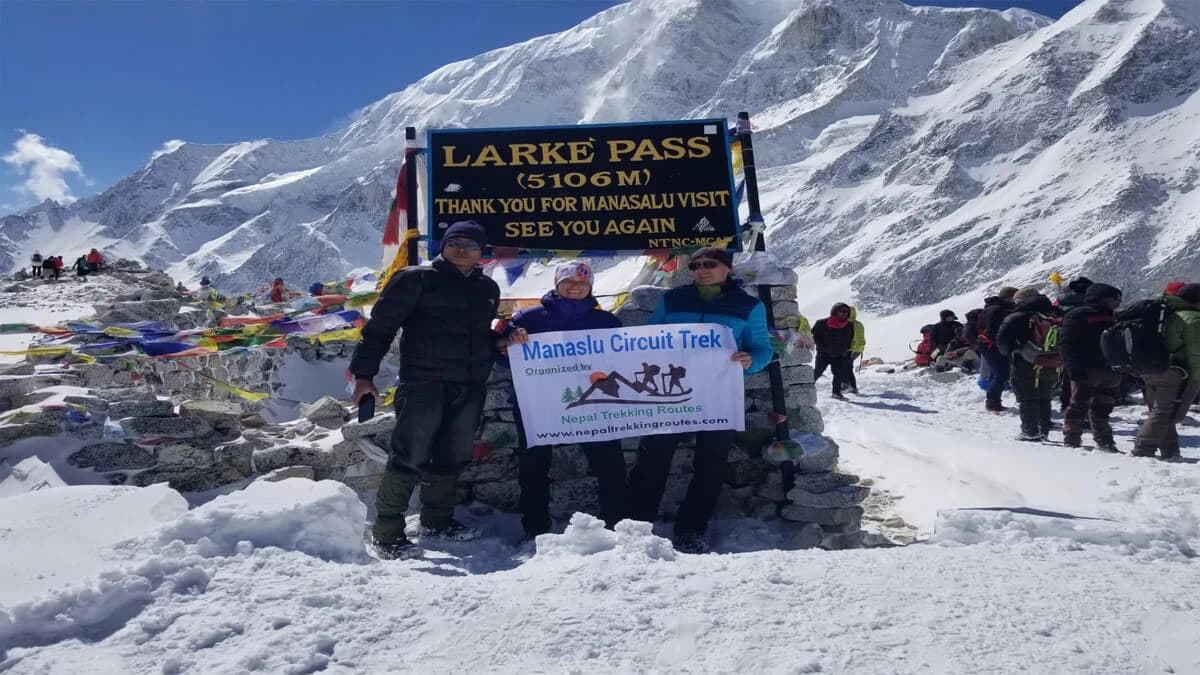
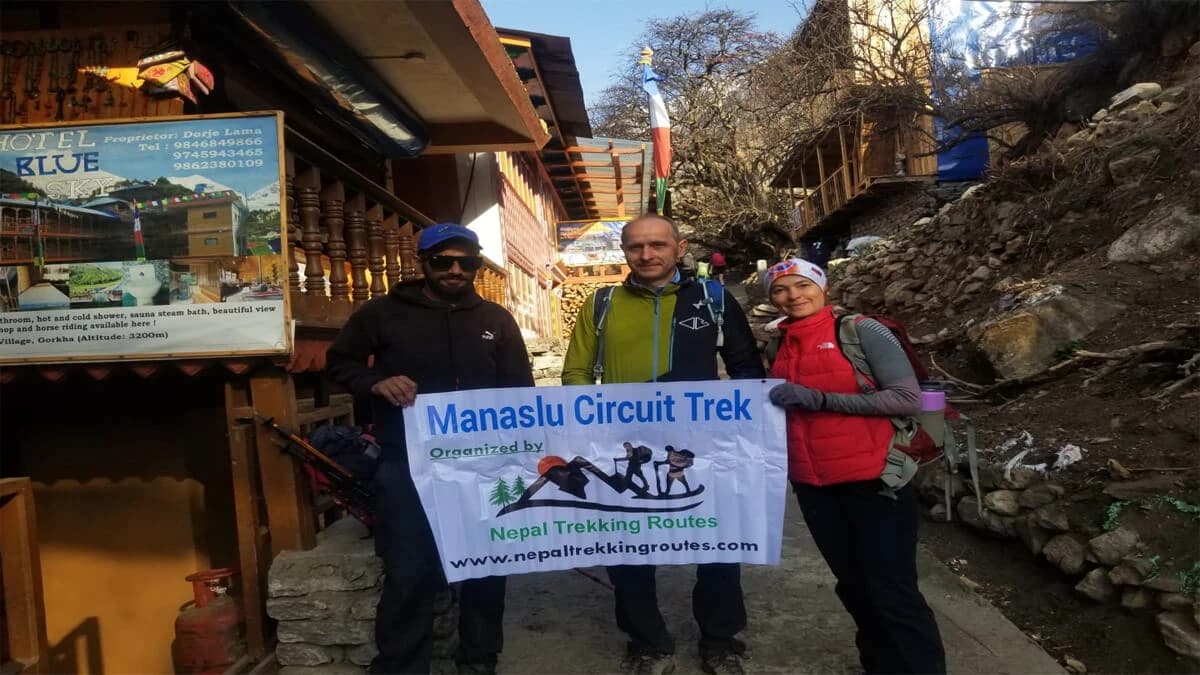
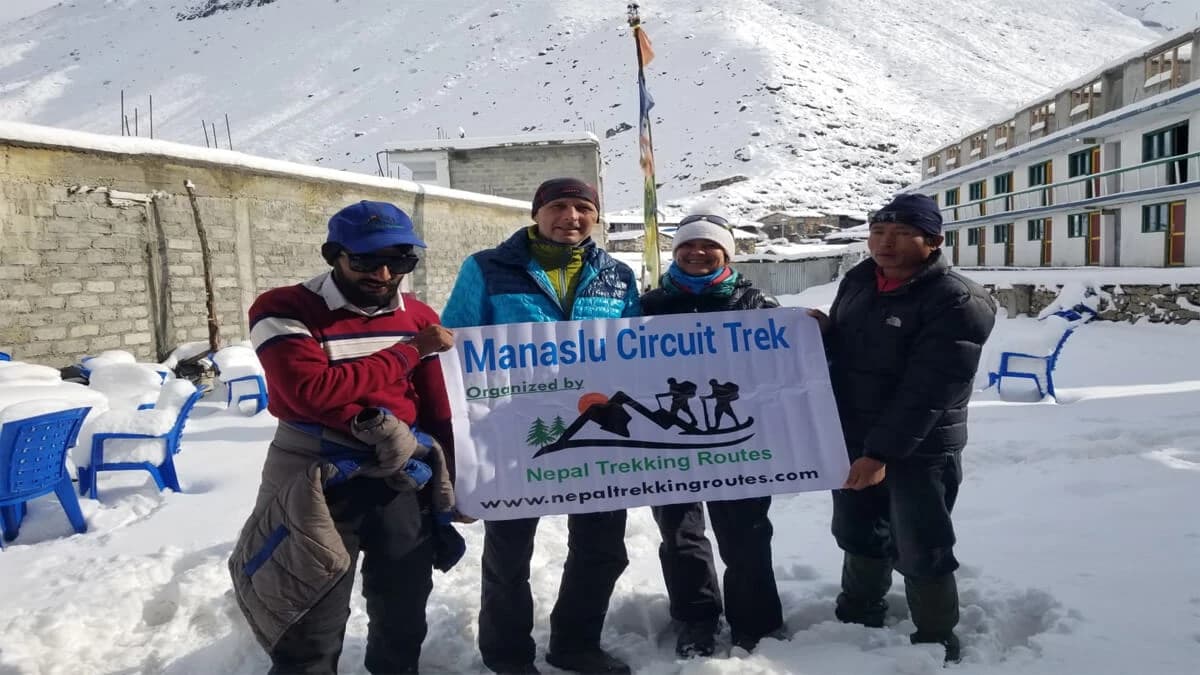

.webp&w=1200&q=75&dpl=dpl_4U3CaZUV3Y5iKdBNPJmVMATJy3AB)
